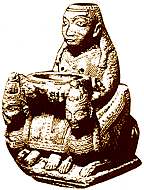 Canaan
/ Israel / Judea /Palestine / Lebanon / Syria
Canaan
/ Israel / Judea /Palestine / Lebanon / Syria Canaan
/ Israel / Judea /Palestine / Lebanon / Syria
Canaan
/ Israel / Judea /Palestine / Lebanon / Syria[King Josiah] demolished the houses of the qadeshim that were in the house of the Lord, where the women wove houses for Asherah. --II Kings, 23:7
Natufian origins. Female iconography of Canaan from the neolithic to the iron age: Sha'ar haGolan, Teleilat el-Ghassul, Jericho, Be'ersheva, Megiddo, Tyre. Ugaritic civilization. The Taanach altarpiece. Conquests, kingdoms, exiles. The goddesses: Asherah, Anat, Ashtaroth. "Sacred women." Asherahs in the high places and in the Temple, and the fight against idolatry. Northern Canaanite ivory sculpture under the Assyrian domination. The last pillar-goddesses. Jordanian votive women and ceramic altarpieces.
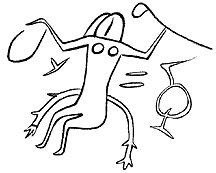 ARABIA
and JORDAN
ARABIA
and JORDANSurely I found a woman ruling over them, and she has been given abundance and she has a mighty throne. I found her and her people adoring the sun instead of Allah... -- Quran, Sura 27:22
Women in ancient rock art. Matrilineage and old marriage customs. Female poets, historians, warriors. Bilqis, queen of Sa'aba, Te'elhunu of Adummatu and Zaynab of Palmyra. The Nabataeans, the Hijazis, the Yemenites. Indo-European origins of veiling and seclusion. Allat, al-Uzza, Manat, the Ka'aba and the new order of Islam. Bedouin weavers. Islamic and secular feminists.
 ANCIENT
IRAQ
ANCIENT
IRAQ Strong, queen, great scribe, queen, great scribe, princess heroic... Kullab I rule, maid of Uruk am I. The temple of Aralu I rule. E-dursabba i rule, the temple of Badgurgur I rule... --Chant of Inanna, Sumer
Female iconography and ceramics at Tell es-Sawwan, Samarra, Jarmo, Tepe Gawra, and other neolithic sites going back to the 8th millennium BCE. Women in Sumeria, Babylonia, and Assyria: farmers, priestesses, and barmaids into heads of state. Sexual politics in cuneiform texts. The tightening of patriarchal laws under successive empires. The now-looted and endangered treasures of one of Earth's most ancient civilizations.
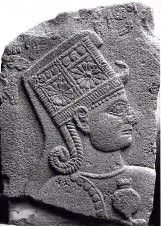 ASIA
MINOR and the CAUCASUS
ASIA
MINOR and the CAUCASUS The Lycians show more honor to the women than to the men; they call themselves after the mother and bequeath her property to their daughters, not their sons. --Nicolaus Damascenus
Great is Artemis of the Ephesians! --Pagan demonstrators in the Christian Bible
Early agricultural villages of Catal Huyuk and Hacilar. Hurrians, Hittites, Phrygians, Ionians, Urartu and Armenia. The ecstatic religion of Kybele, Ma, and Kubaba. Artemis of Sardis and Ephesus. Anatolian priestesses, Christianity and Islam. Armenia, Ossetia, Daghestan, Georgia. The Turks. Kilim weavers and farmers.
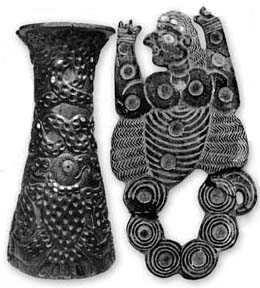 IRAN
/ AFGHANISTAN
IRAN
/ AFGHANISTAN[Qurrat al-'Ayn] rose from her seat and, undeterred by the tumult that she had raised in the hearts of her companions... she delivered her appeal with matchless eloquence and profound fervor. ... Immediately after, she declared, 'I am the Word which the Qa'im is to utter, the Word which shall put to flight the chiefs and nobles of the earth.' -- Sheikh Abu-Turab
Neolithic ceramics. Ancient Elam, Magan, Bactria. Women in the Iranian empires. Persian carpet weavers, musicians, court women and travelling folk. Depictions of women in art and literature. Purdah. Kafir Kalash: the "Black Pagans" of the Kush highlands. Female liabilities in modern Iran, Pakistan and Afghanistan, and the women's rights activists who are working for change.
A king's son who was the strongest in his kingdom offered 1000 horses in challenge, and a great multitude came to see the fight. At last the king's daughter vanquished him and threw him on the pavement most violently.
--- Marco Polo, Tatar Relation
Archaelogy of Kazakhstan, Uzbekistan, the Altai and Xinjiang. Female iconography in Buddhist murals. Turkic legends of amazons and female shamans. The Muslim conquest, Mongol armies, Russian domination. Women's arts: knotted carpets and felt mosaics.
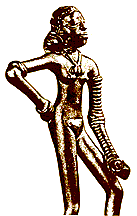 ANCIENT
INDIA
ANCIENT
INDIAIndus civilization: not only the better-known sites of Mohenjo-Daro and Harappa, but older sites of Mergarh, Kulli. Women in Vedic tradition and sexual politics among gods and goddesses. The indigenous Adivasi: "Dwellers from the beginning." Female images in the art of Sanchi, Ellura, and Ajanta. The Sapta Matrikas. Patriarchy and caste in the Laws of Manu. Mother-right and female-positive traditions among the Dalit (oppressed classes/ethnicities).Women were not formerly immured in houses and dependent on husbands and relatives. They used to go about freely, enjoying themselves as they pleased best. --the Mahabharata
Goddess veneration in Indi: an iconographic feast, from clay figures of the ancient Indus to the rock-cut "Seven Mothers" and modern Hindu religious art. Shakti pithas, serpent groves, yoni kundas and litanies of the Thousand Names of the Goddess. Adi Parashakti. Saptamatrkaa. Mariamma. Kali Ma. Lakshmi. Manasa. Shasthi. Bhairavi. Durga. Ushas. Sri. Umaa. Lalitaa. Chandika. Minakshi. Parvati. Sarasvati. Mukambika. Tripurasundari. Kamakhya. Sarasvati.O Devi! When Brahma was not, Vishnu was not, Maheshvara was not, nor when yet existing Indra, Varuna, Kuvera, Yama and Agni, Thou alone existed then. My salutations to thee. --Vyasa in the Devi Bhagavatam Purana

Temple art of Nepal. Taleju and the Kumaris. Village life and weaving. Bönpo and Buddhism in Tibet: female imagery in thangkas and sculpture. Jetsunmas (women religious authorities) and bhikshunis (nuns). Women in the countryside. Tibetan sovereignty movement. Women in Mongolia from the middle ages to the present.There are many who wish to gain enlightenment in a man's form, and there are but few who wish to work for the welfare of living beings in a female form. Therefore may I, in a female body, work for the welfare of beings until Samsara has been emptied. --Origin of Tara Tantra, circa 1600
In the old days the wisdom of women was held to be the true wisdom of the people, and it was seldom the men failed to be guided by it.
--Alexandra Ovchinninkova, Yakut leader
Paleolithic goddesses of Siberia. Rock writings of the Lena River. Ancient ceramics, petroglyphs, and fabric arts of the Amur River. Women shamans, housemakers and hunters. Karyndash clans in the Altai: "of one womb." Yakut ceremonial and art. Peoples of the Urals, the Arctic and Kamchatka. The impact of 500 years of Russian conquest, and the revitalization of indigenous culture.
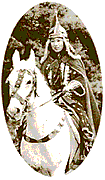 JAPAN
JAPAN
If a man from any other place weds a woman from this place, he straightway droops and dies. -- Japanese proverb on Onna-Taki ("Woman Hill"), named for its tradition of female-headed clans.
Women in the archaeology of the Jomon and Yayoi periods. The indigenous Ainu. Female chieftains and mikogami (women shamans) in haniwa ceramic art. Lady Murasaki, the world's first novelist, and other medieval literary women. Rural women: farming, fabric arts, and folk ritual. Okinawan priestesses, shamans, pearl divers, and matrilocal custom. Japanese women in the early modern period, including the renegade nun Okuni who founded Kabuki theater. The Seito society; feminist and anarchist activists in the age of industrialization.
During the age of Shen Neng, people rested at ease and acted with vigor./ They cared for their mothers, not for their fathers....
They did not think of harming one another. ---Zhuang ZeA young girl's heart is sad and troubled, fearing that she may have to go home with her lord. -- the Book of Odes
Neolithic ceramics and bronzes of old China. Ritual leadership by the Wu, female shamans. Taoist cosmology: Heaven and Yellow Land Earth Queen. Matrilineal clans of Hsia give way to a patriarchal system under the Shang. The powerful queen Fu Hao. Women under feudalism and Confucian codes, in the fields and the imperial court: farmers, warriors, and peasant rebels.
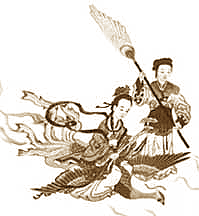 CHINA
II
CHINA
II China after the Han dynasty. The rise of Buddhism and the emergence of Guan Yin, Miao Shan, Ma Tzu, and Tian Hou. Empress Wu Tse Tien defies the Confucian code. Female calligraphers, scholars, herbalists, bandits, marriage resisters, Taoists and Buddhists. Village and family life. Slavery, concubinage, and footbinding. Qiu Jin, Ding Ling, and modern Chinese feminism. Indigenous nationalities, including the matrilineal Mosuo and other egalitarian societies of Yunnan.
"Women had the right to stop war by the custom of that time. The two sides had to stop fighting if a woman of either side waves her skirt and calls for an armistice." --old Lisu man, Yunnan
The bronzes of ancient Shih-Zhai-Shan. Quite a number of the highland cultures in southwest China are matrilineal, and strong traditions of gender egalitarianism are seen in many others. The Mosuo, known to the Chinese as the Kingdom of Daughters, and their female clan heads (dabu). Lahu, Jingpaw, Pumi, Lisu, Jinuo, Norsu, Wa, Drung, and Dulong. Female drummers, womanhood inititations, female courtship, and stigma-free youthful affairs in the "flower houses." Female drummers and traditions of powerful women shamans, inventors, and saviors. Also, the patrilineal Yi, Hmong, and Yao. The indigenous mother-right cultures of pre-colonial Taiwan.
In this country it is the women who engage in commerce... Each day a market is held from six to noon.
--Chinese traveller in CambodiaMy wish is to ride the tempest, tame the waves, kill the sharks. I want to drive the enemy away to save our people. I will not resign myself to the usual lot of women who bow their heads and become concubines. --Trieu Thi Trinh, leader of a Vietnamese rebellion against Chinese rule in 248 CE
Khmer women judges, traders, musicians. Iconography of Anghor Wat and other temple complexes. Mother-right longhouses in a Vietnam that Chinese writers called the "Country of Women." Women in Burma, Thailand, Laos and Yunnan, including many indigenous mother-right cultures with high female status.
Beautiful goddess stand up, stand up. The singers have come and are singing the sanghyang.
Come goddess, goddess, we ask of the nymphs to come to us for a while and go around, go around. -- Balinese chant
The Black cultures of ancient Indonesia. Megalithic buffalo women of Sumatra. Mother-clans of the Menangkabau. Fine weaving, batik, ikat and other textile arts. Temples, dancers and priestesses and dancers of Java and Bali. The eastern islands. Sovereignty movements. The growth of Islam in Java and Sumatra. Globalization and the impact of logging, oil, and other extraction industries.